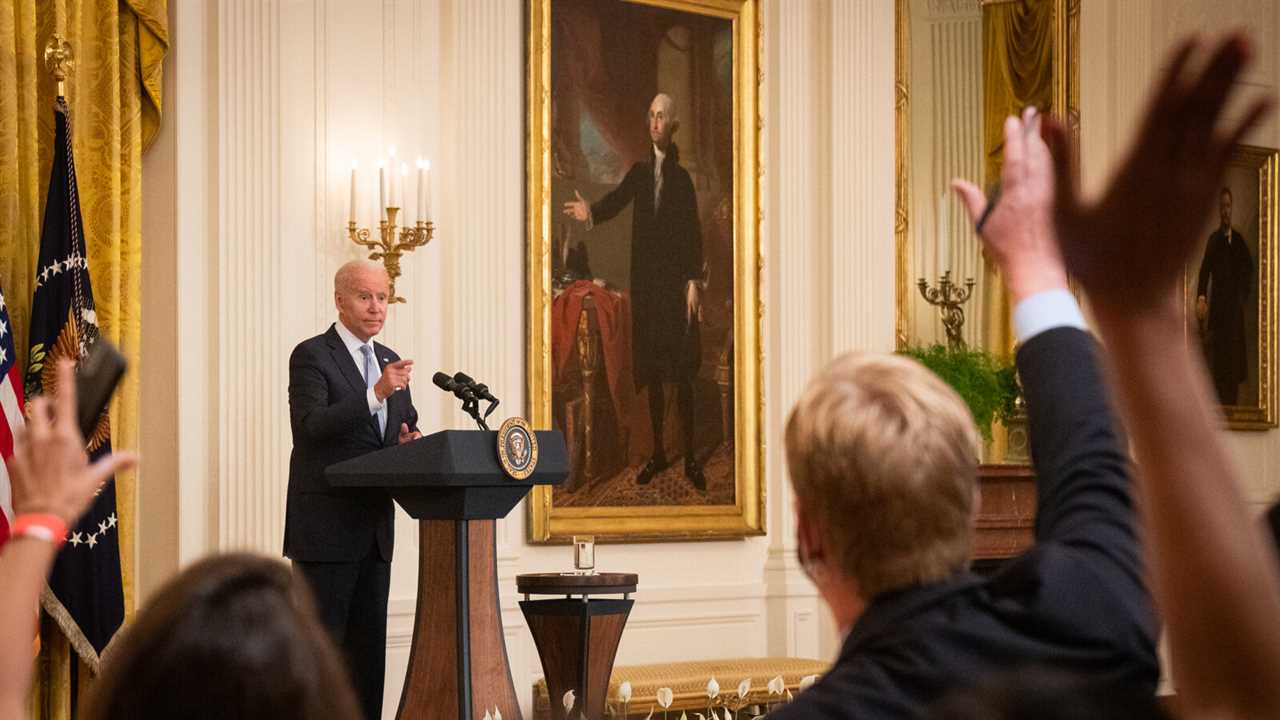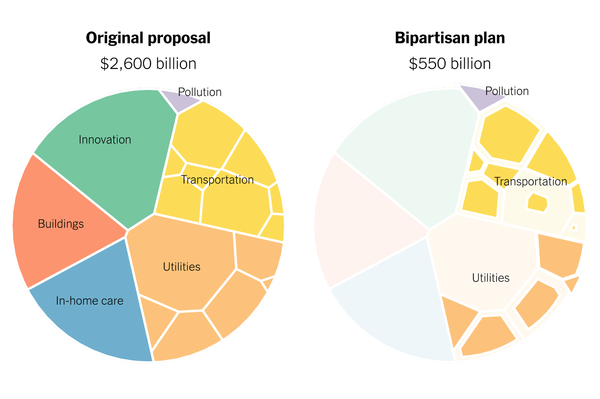
WASHINGTON — President Biden’s success at propelling an infrastructure deal past its first major hurdle this week was a vindication of his faith in bipartisanship and a repudiation of the slash-and-burn politics of his immediate predecessor, President Donald J. Trump, who tried and failed to block it.
Having campaigned as the anti-Trump — an insider who regarded compromise as a virtue, rather than a missed opportunity to crush a rival — Mr. Biden has held up the promise of a broad infrastructure accord not just as a policy priority but as a test of the fundamental rationale for his presidency.
His success or failure at keeping the bill on track will go a long way to determining his legacy, and it could be the president’s best chance to deliver on his bet that he can unite lawmakers across the political aisle to solve big problems, even at a time of intense polarization.
“President Biden ran on the message that we need to bring people together to meet the challenges facing our country and deliver results for working families,” Mike Donilon, a senior adviser to the president, wrote in a memo the White House released on Thursday, as senior officials crowed about the significance of the accord. “And the American people embraced that message. While a lot of pundits have doubted bipartisanship was even possible, the American people have been very clear it is what they want.”
That may be the case, but the vote on Wednesday that paved the way for the Senate to consider the bipartisan infrastructure plan was no guarantee that the effort would succeed. The measure still has several hurdles to clear, including anger from progressives in the House who are upset at the concessions Mr. Biden made to court Republicans, and skepticism from G.O.P. lawmakers who could still balk at a bill Mr. Trump has repeatedly panned.
For now, though, Mr. Biden has managed to do what Mr. Trump repeatedly promised but never could pull off: move forward on a big-spending, bipartisan deal to rebuild American roads, bridges, water pipes and more. He did so with the support of 17 Republicans during a week marked by bitter partisan disputes in Congress over mask-wearing and the Jan. 6 attack on the Capitol.
Mr. Biden had pursued centrist Republicans and Democrats for months in hopes of forging an agreement to lift federal spending on roads, bridges, water pipes, broadband internet and other physical infrastructure. In recent weeks, aides said, he requested multiple daily briefings on negotiations, personally directed administration strategy on policy trade-offs and frequently phoned moderates from both parties to keep the pressure on for a final deal.
The resulting agreement, which would pour $550 billion in new funding into physical infrastructure projects, is another step toward securing the next plank of Mr. Biden’s $4 trillion economic agenda. The White House has called it the largest infrastructure investment since the creation of the interstate highway system in the 1950s, and Democrats hope it comes with a much larger bill to invest in child care, affordable housing, higher education, programs to tackle climate change and more.

The Infrastructure Plan: What’s In and What’s Out
Comparing the infrastructure plan President Biden proposed in March with the one the Senate may take up soon.
Whether the president can see the deal all the way through could determine how much of his agenda to overhaul American capitalism and rebuild the middle class actually becomes law. Some moderate Democrats in the Senate have conditioned their support for any larger, partisan legislation on first completing a bipartisan infrastructure bill.
The bipartisan agreement is loaded with the first tranche of Mr. Biden’s policy priorities. Administration officials say the deal, if signed into law, would replace every lead drinking water pipe in the country, repair potholed roads and crumbling bridges, further build out a national network of charging stations for electric vehicles and give every American access to high-speed internet.
Mr. Biden would have liked to go much further in all those areas. But he trimmed his ambitions to win Republican support, keep centrist Democrats happy and practice the sort of compromise he has long preached on the campaign trail.
Mr. Biden was motivated to run for president, in part, by a belief that Washington had lost its ability to find common ground and faith that it was possible to revive the spirit of bipartisanship that he cherished in his 36-year Senate career.
Politics Updates
- Biden signals support for Democrats’ plan to advance immigration changes unilaterally, via a budget bill.
- The widow of a D.C. policeman who shot himself after Jan. 6 wants his death marked ‘in the line of duty.’
- The Justice Dept. tells the Texas governor his new Covid rule restricting migrant transports violates federal law.
That belief was tested in recent weeks, after Mr. Biden announced the framework of an agreement on infrastructure with a bipartisan group of senators at the White House in June. Lawmakers struggled to fill in the policy details. Interest groups pressured Democrats to spend more and Republicans to drop a large revenue source for the original deal, a plan to step up I.R.S. enforcement to catch tax cheats. An early test vote on the measure failed in the Senate.
In the waning moments, another source of pressure emerged: Mr. Trump, who continues to push the lie that the election was stolen from him, and to influence many Republican members of Congress.
As a candidate in 2016, Mr. Trump had promised to push a large infrastructure bill — larger, he claimed, than his Democratic rival Hillary Clinton. He doubled down on that promise as president-elect and talked it up often as president. But he never came close to delivering on it, and “Infrastructure Week” became a running joke in Washington, encapsulating the Trump administration’s penchant for veering off message and how a goal both parties ostensibly agreed upon could never seem to be reached.
As Mr. Biden pushed toward a deal in recent weeks with a group of Republican and Democratic negotiators in the Senate — including Senator Mitt Romney, Republican of Utah, a longtime foil of Mr. Trump’s — the former president blasted out news releases, urging his party to walk away.
“Hard to believe our Senate Republicans are dealing with the radical left Democrats in making a so-called bipartisan bill on ‘infrastructure,’ with our negotiators headed up by super RINO Mitt Romney,” Mr. Trump wrote in a Wednesday statement, referring to the Utah senator with the acronym for Republican in name only. “This will be a victory for the Biden administration and Democrats, and will be heavily used in the 2022 election. It is a loser for the U.S.A., a terrible deal, and makes the Republicans look weak, foolish and dumb.”
Soon after, the agreement moved forward in the Senate. Seventeen Republicans voted to take it up, including the Republican leader, Mitch McConnell of Kentucky, who has taken pains to distance himself from Mr. Trump in recent months. It was not clear whether the minority leader, who has previously said he was “100 percent focused” on stopping Mr. Biden’s agenda, would ultimately support the bill.
Still, Mr. Biden — who once brokered deals with Mr. McConnell — was personally invested in pursuing a compromise, administration officials said, calling upon his experience as a deal-maker in the Senate.
“Biden and his team was willing to patiently work together with Republicans, and Trump and his team were not willing to do that with Democrats,” said Senator Tim Kaine, Democrat of Virginia. He added, “I give tremendous credit to the senators who’ve done this, but I will have to say, an ingredient that is necessary is a White House that really wants to do it, that will reach out across the aisle and will stay at the table.”
Mr. Biden also dispatched top legislative aides and members of his Cabinet to reach out to lawmakers in both parties. Senator Kevin Cramer, Republican of North Dakota, said he received repeated calls from Jennifer Granholm, the secretary of energy, and legislative staff members — “always very gently and respectfully” — to discuss the emerging deal and “take my temperature” before he voted to advance the measure.
Multiple senators said the president and his team spent hours with them in person on Capitol Hill and on the phone hashing out the details of the legislation, including thorny disagreements over how to finance billions of dollars in new spending.
“Joe’s experience in the Senate paid dividends in the presidency,” said Senator Jon Tester, Democrat of Montana, one of the 10 Senate negotiators. “Joe’s willingness to compromise made a huge difference.”
Mr. Trump and his team never put in a similar effort. They waited a year into his presidency to release an infrastructure plan, which many lawmakers quickly dismissed as unserious. As talks were about to get underway, he blew them up in a blast of anger at Democrats. His legislative team never put real muscle into finding a deal on the issue, or even into trying to ram through a partisan plan, as it did with his signature tax cuts in 2017.
The former president was similarly disengaged in his effort to stop Mr. Biden’s bipartisan agreement. While Mr. Trump fired off news releases grousing about the talks, Mr. Biden hosted members of Congress in the Oval Office more than a dozen times in recent weeks. Home in Delaware last weekend, he repeatedly dialed up negotiators to talk on the phone.
Even in a gridlocked Washington, that sort of effort can still be the art of the deal.
Emily Cochrane contributed reporting.
Did you miss our previous article...
https://trendinginthenews.com/usa-politics/chinas-new-ambassador-to-the-us-arrives-amid-heightened-tensions-between-the-two-nations






